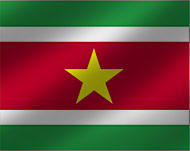Country profile: Suriname
Suriname is the smallest independent country on the South American continent and is in danger of becoming an important transhipment point for illicit drugs and weapons.

The Dutch West India Company was founded in 1621 to exploit the territory that today encompasses Suriname. Dutch supremacy was periodically interrupted by English and French attacks and by a slave insurrection in 1762–63.
The English territory of Guiana was given to the Dutch in the Treaty of Breda, but in 1815, the Congress of Vienna gave the area that is now known as Guyana to Britain while reaffirming the Dutch supremacy over what is now Suriname.
In 1954, Suriname officially became a self-governing part of the kingdom of the Netherlands and became fully independent in 1975. In 1980, a military government replaced the civilian one with a socialist republic.
It continued to rule until 1987, when international pressure finally forced a democratic election. Many guerilla groups formed during the turbulent 1980s and did considerable damage to the fragile infrasctructure.
Democracy was restored in 1988 and guerrilla activity decreased. In 1989, the military once again overthrew the civilian government, but an elected government returned to power in 1991.
 |
|
Suriname’s flag |
The Republic of Suriname (formerly known as Netherlands Guiana and Dutch Guiana) lies between French Guiana to the east and Guyana to the west and is in the northern part of the South American continent. It shares a border with Brazil in the south and the northern border is the Atlantic ocean.
The tiny country is involved in border disputes with its neighbour, French Guiana. Its neighbour to the west, Guyana, is seeking United Nations arbitration to settle its dispute with Suriname over oil-rich waters.
The population of Suriname is small and situated mostly along the coastline. The terrain consists of tropical rainforest with rolling hills and swamps and it is home to many species of diverse flora and fauna.
Capital: Paramaribo
Official name: Republic of Suriname
Government type: Constitutional democracy
Population: 438,144
Languages: Dutch (official), English (widely spoken), Sranang Tongo (Surinamese, sometimes called Taki-Taki, is native language of Creoles and much of the younger population and is the language of choice among others), Hindustani (a dialect of Hindi), Javanese.
Ethnic diversity: Hindustani 37%, Creole (mixed white and black) 31%, Javanese 15%, Maroons (their African ancestors were brought to the country in the 17th and 18th centuries as slaves and escaped to the interior) 10%, Amerindian 2%, Chinese 2%, white 1%, other 2%.
Literacy rate: Total population over 15 years of age: 93%;
male: 95%; female: 91% (1995 estimate)
Religion: Hindu 27.4%, Protestant 25.2% (predominantly Moravian), Roman Catholic 22.8%, Muslim 19.6%, indigenous beliefs 5%.
Political parties and leaders: More than 17 political parties participate in the Suriname democracy that is based on its 1987 constitution. The government is the National Assembly, which consists of 51 members. These members are elected every five years.
The assembly elects the head of the executive branch, the president, by a two-third majority. If no candidate achieves such a majority, the president is elected by the People’s Assembly, a 340-member institute consisting of the National Assembly and regional representatives.
Political pressure groups and leaders: Association of Indigenous Village Chiefs, leader Ricardo Pane; Association of Saramaccan Authorities or Maroon, head Captain Wase; Women’s Parliament Forum or PVF, Iris Gilliad.
International organisation participation includes: ACP, Caricom, FAO, G-77, IADB, IBRD, ICAO, ICFTU, ICRM, IDB, IFAD, IFRCS, IHO, ILO, IMF, IMO, Interpol, IOC, ITU, LAES, MIGA, NAM, OAS, OIC, OPANAL, OPCW, PCA, UN, UNCTAD, UNESCO, UNIDO, UPU, WCL, WHO, WIPO, WMO, WTO.
Military branches: National Army (includes small Navy and Air Force elements).
Military manpower – military age: 18 years of age, there is no conscription.
Military manpower: There are approximately 111,582 males aged between 18 and 49.
Geography
Location: Northern South America, bordering the North Atlantic Ocean, between French Guiana and Guyana.
Area: total: 163,270sq km; land: 161,470sq km; water: 1800 sq km.
Land boundaries: Total: 1707km; border countries: Brazil 597km, French Guiana 510km, Guyana 600km
Coastline: 386km
Maritime claims: Territorial sea: 12 nm; exclusive economic zone: 200 nm
Climate: Tropical; moderated by trade winds
Terrain: Mostly rolling hills; narrow coastal plain with swamps.
Natural resources: Timber, hydropower, fish, kaolin, shrimp, bauxite, gold, and small amounts of nickel, copper, platinum, iron ore.
Land use: Arable land: 0.37%; permanent crops: 0.06%; other: 99.57% (2001).
Environment – current issues: Deforestation as timber is cut for export; pollution of inland waterways by small-scale mining activities.
Environment – international agreements: Suriname is party to: Biodiversity, Climate Change, Desertification, Endangered Species, Law of the Sea, Marine Dumping, Ozone Layer Protection, Ship Pollution, Tropical Timber 94, Wetlands.
Economy: The strongest impact on Suriname’s economy comes from the bauxite industry, bauxite accounts for 70% of export earnings.
Agriculture accounts for around 15% of the gross domestic product. The main crop is rice but sugarcane, coffee, bananas, and coconuts are also cultivated.
Suriname must introduce structural reforms in its monetary and fiscal policies to help bolster its present economic prospects.
The Dutch Government has agreed to restart the previously suspended flow of aid, which will potentially allow Suriname to access international development financing.
GDP: $3373.52 per person
GDP – real growth rate: 4.2% (2004 est)
Industries: Bauxite and gold mining, alumina production, oil, lumbering, food processing, fishing
Exports: Alumina, crude oil, lumber, shrimp and fish, rice, bananas.
Import: Capital equipment, petroleum, foodstuffs, cotton, consumer goods.
Labour force: 104,000 (2003)
Unemployment rate: 17% (2000)
Currency: Surinamese Guilder (SRG)
Sources: Politinfo.com, CIA World fact book, Infoplease.com, Nationmaster.com